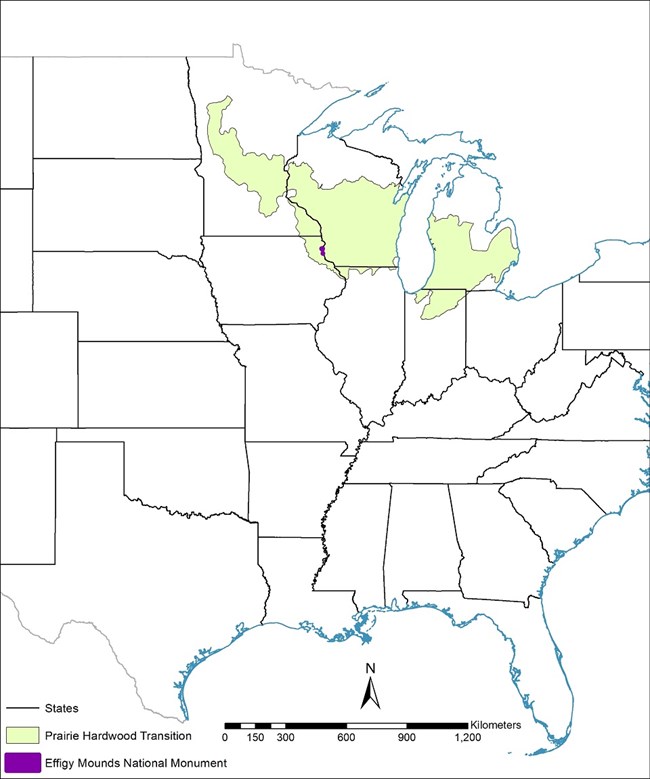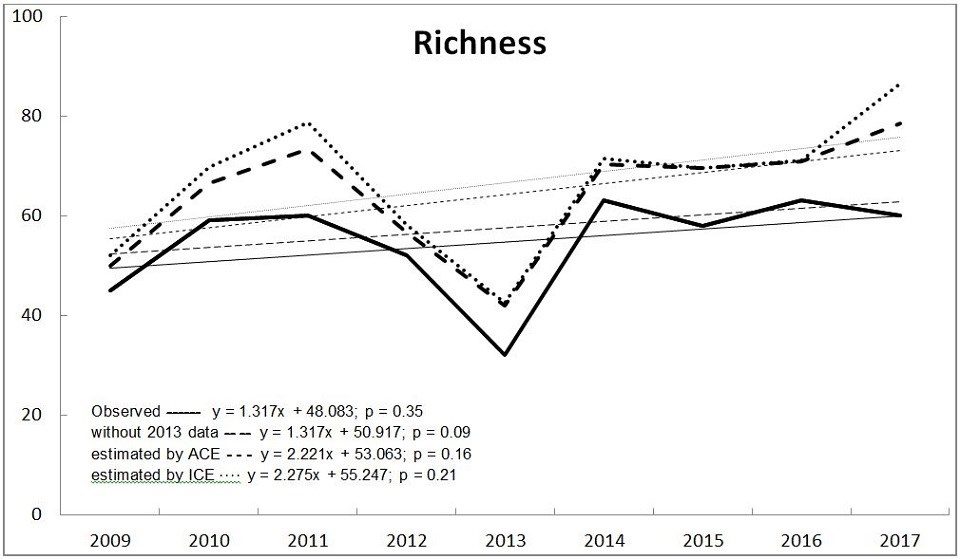Last updated: October 8, 2020
Article
Bird Community Monitoring at Effigy Mounds National Monument

NPS-Photo

NPS
Birds are an important part of the world we live in. Birds eat pests, disperse seeds, pollinate plants, feed us, and provide us with recreational activities. Park interpretive programs often feature birds because of the enjoyment they provide. Birds are also great indicators of environmental change. Birds serve as the "canary in the coal mine" so to speak for an ecosystem. Unfortunately, many birds like the Northern Bobwhite are declining in numbers.
Scientists measure changes in bird numbers and habitat to determine the health of bird communities. They survey birds in the park during the breeding season. They also survey habitat structure and composition during this time. Together, the data helps researchers to determine responses of birds to their habitat. Regional surveys are also studied to determine local vs. regional trends.
* M = migrant through the area; R = year around resident; SR = summer resident; T = transient.
| Common name | Species name | AOU code | Residency* |
| Acadian Flycatcher | Empidonax virescens | ACFL | SR |
| Alder Flycatcher | Empidonax alnorum | ALFL | M |
| American Crow | Corvus brachyrhynchos | AMCR | R |
| American Goldfinch | Spinus tristis | AMGO | R |
| American Redstart | Setophaga ruticilla | AMRE | SR |
| American Robin | Turdus migratorius | AMRO | SR |
| Bald Eagle | Haliaeetus leucocephalus | BAEA | R |
| Baltimore Oriole | Icterus galbula | BAOR | SR |
| Barn Swallow | Hirundo rustica | BARS | SR |
| Belted Kingfisher | Megaceryle alcyon | BEKI | R |
| Black-and-white Warbler | Mniotilta varia | BAWW | SR |
| Black-billed Cuckoo | Coccyzus erythropthalmus | BBCU | SR |
| Black-capped Chickadee | Poecile atricapillus | BCCH | R |
| Blackpoll Warbler | Setophaga striata | BLPW | M |
| Black-throated Green Warbler | Setophaga virens | BTNW | M |
| Blue Jay | Cyanocitta cristata | BLJA | R |
| Blue-headed Vireo | Vireo solitarius | BHVI | M |
| Blue-gray Gnatcatcher | Polioptila caerulea | BGGN | SR |
| Blue Grosbeak | Passerina caerulea | BLGR | T |
| Blue-winged Warbler | Vermivora pinus | BWWA | SR |
| Brown Creeper | Certhia americana | BRCR | R |
| Brown Thrasher | Toxostoma rufum | BRTH | SR |
| Brown-headed Cowbird | Molothrus ater | BHCO | SR |
| Canada Goose | Branta canadensis | CAGO | R |
| Canada Warbler | Cardellina canadensis | CAWA | M |
| Carolina Wren | Thryothorus ludovicianus | CARW | R |
| Cedar Waxwing | Bombycilla cedrorum | CEDW | SR |
| Cerulean Warbler | Setophaga cerulean | CERW | SR |
| Chimney Swift | Chaetura pelagica | CHSW | SR |
| Chipping Sparrow | Spizella passerina | CHSP | SR |
| Cliff Swallow | Petrochelidon pyrrhonota | CLSW | SR |
| Common Grackle | Quiscalus quiscula | COGR | SR |
| Common Yellowthroat | Geothlypis trichas | COYE | SR |
| Cooper’s Hawk | Accipiter cooperii | COHA | SR |
| Dark-eyed Junco | Junco hyemalis | DEJU | M |
| Dickcissel | Spiza americana | DICK | SR |
| Downy Woodpecker | Picoides pubescens | DOWO | R |
| Eastern Bluebird | Sialia sialis | EABL | SR |
| Eastern Kingbird | Tyrannus tyrannus | EAKI | SR |
| Eastern Meadowlark | Sturnella magna | EAME | SR |
| Eastern Phoebe | Sayornis phoebe | EAPH | SR |
| Eastern Towhee | Pipilo erythrophthalmus | EATO | SR |
| Eastern Wood-pewee | Contopus virens | EAWP | SR |
| European Starling | Sturnus vulgaris | EUST | R |
| Field Sparrow | Spizella pusilla | FISP | SR |
| Grasshopper Sparrow | Ammodramus savannarum | GRSP | SR |
| Gray Catbird | Dumetella carolinensis | GRCA | SR |
| Great Blue Heron | Ardea herodias | GBHE | SR |
| Great Crested Flycatcher | Myiarchus crinitus | GCFL | SR |
| Hairy Woodpecker | Picoides villosus | HAWO | R |
| Hermit Thrush | Catharus guttatus | HETH | M |
| Hooded Merganser | Lophodytes cucullatus | HOME | SR |
| Hooded Warbler | Setophaga citrina | HOWA | SR |
| House Finch | Carpodacus mexicanus | HOFI | R |
| House Wren | Troglodytes aedon | HOWR | SR |
| Indigo Bunting | Passerina cyanea | INBU | SR |
| Kentucky Warbler | Geothlypis formosa | KEWA | SR |
| Killdeer | Charadrius vociferus | KILL | SR |
| Least Flycatcher | Empidonax minimus | LEFL | SR |
| Mallard | Anas platyrhynchos | MALL | SR |
| Mourning Dove | Zenaida macroura | MODO | SR |
| Northern Cardinal | Cardinalis cardinalis | NOCA | R |
| Northern Flicker | Colaptes auratus | YSFL | R |
| Northern Parula | Setophaga americana | NOPA | SR |
| Northern Rough-winged Swallow | Stelgidopteryx serripennis | NRWS | SR |
| Olive-sided Flycatcher | Contopus cooperi | OSFL | M |
| Ovenbird | Seiurus aurocapilla | OVEN | SR |
| Pileated Woodpecker | Dryocopus pileatus | PIWO | R |
| Prothonotary Warbler | Protonotaria citrea | PROW | SR |
| Red-bellied Woodpecker | Melanerpes carolinus | RBWO | R |
| Red-eyed Vireo | Vireo olivaceus | REVI | SR |
| Red-headed Woodpecker | Melanerpes erythrocephalus | RHWO | R |
| Red-shouldered Hawk | Buteo lineatus | RSHA | R |
| Red-tailed Hawk | Buteo jamaicensis | RTHA | R |
| Red-winged Blackbird | Agelaius phoeniceus | RWBL | R |
| Rose-breasted Grosbeak | Pheucticus ludovicianus | RBGR | SR |
| Ruby-throated Hummingbird | Archilochus colubris | RTHU | SR |
| Scarlet Tanager | Piranga olivacea | SCTA | SR |
| Sedge Wren | Cistothorus platensis | SEWR | SR |
| Song Sparrow | Melospiza melodia | SOSP | R |
| Spotted Sandpiper | Actitis macularius | SPSA | SR |
| Swainson’s Thrush | Catharus ustulatus | SWTH | M |
| Swamp Sparrow | Melospiza georgiana | SWSP | SR |
| Tennessee Warbler | Leiothlypis peregrina | TEWA | M |
| Tree Swallow | Tachycineta bicolor | TRES | SR |
| Tufted Titmouse | Baeolophus bicolor | ETTI | R |
| Turkey Vulture | Cathartes aura | TUVU | SR |
| Veery | Catharus fuscescens | VEER | SR |
| Warbling Vireo | Vireo gilvus | WAVI | SR |
| White-breasted Nuthatch | Sitta carolinensis | WBNU | R |
| White-eyed Vireo | Vireo griseus | WEVI | SR |
| Willow Flycatcher | Empidonax traillii | WIFL | SR |
| Wilson’s Warbler | Cardellina pusilla | WIWA | M |
| Wild Turkey | Meleagris gallopavo | WITU | R |
| Wood Duck | Aix sponsa | WODU | SR |
| Wood Thrush | Hylocichla mustelina | WOTH | SR |
| Worm-eating Warbler | Helmitheros vermivorum | WEWA | SR |
| Yellow Warbler | Setophaga petechia | YWAR | SR |
| Yellow-bellied Sapsucker | Sphyrapicus varius | YBSA | SR |
| Yellow-breasted Chat | Icteria virens | YBCH | SR |
| Yellow-billed Cuckoo | Coccyzus americanus | YBCU | SR |
| Yellow-throated Vireo | Vireo flavifrons | YTVI | SR |

NPS
Scientists have recorded 102 bird species in the park over the last 9 years. Ninety of the bird species are breeding species. Eight of the bird species are of concern for the region. The American Redstart, American Robin, Baltimore Oriole, and Blue-gray Gnatcatcher were common species. Twenty-three species were common enough to calculate trends in their numbers. American Redstart, Brown-headed Cowbird, Common Yellowthroat, Red-winged Blackbird, and Rose-breasted Grosbeak numbers increased. Populations of Brown-headed Cowbird, Common Yellowthroat, and Red-winged Blackbird declined within the region. Most populations on the park are doing better than the region. Unchanging species richness suggests habitat on the park has remained similar across years.

NPS
Bird population changes may reflect habitat management activities. For that reason scientists track changes in bird populations and habitat over time. This improves the parks efforts to manage habitat for birds. Preserving habitat for birds preserves entire ecosystems for the benefit of all species.
Visit the Effigy Mounds National Monument Volunteer Bird Monitoring page.
Learn more about the Heartland Inventory & Monitoring Network.
Data in this report were collected and analyzed using methods based on established, peer-reviewed protocols and were analyzed and interpreted within the guidelines of the protocols.
